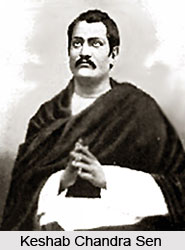 Sangat Sabhas (Believer`s Associations) were formed by Keshab Chandra Sen in 1860. These sabhas were comprised of small discussion groups that met weekly, but his energetic disciples soon showed an inclination for action rather than mere discussions. Their militancy encouraged them to discard caste and the sacred thread, to practice self-control and work for the equality of women. Their wish to unite belief and action emerged from the learning of Hindu and Christian writings. Keshab Chandra Sen`s disciples increased steadily during the 1860s, bringing with them a longing for social radicalism and a growing missionary programme all across Bengal. There was also a widening distance between the younger and older members of the Sangat Sabhas.
Sangat Sabhas (Believer`s Associations) were formed by Keshab Chandra Sen in 1860. These sabhas were comprised of small discussion groups that met weekly, but his energetic disciples soon showed an inclination for action rather than mere discussions. Their militancy encouraged them to discard caste and the sacred thread, to practice self-control and work for the equality of women. Their wish to unite belief and action emerged from the learning of Hindu and Christian writings. Keshab Chandra Sen`s disciples increased steadily during the 1860s, bringing with them a longing for social radicalism and a growing missionary programme all across Bengal. There was also a widening distance between the younger and older members of the Sangat Sabhas.
In 1862 Keshab Chandra Sen and his followers furtively celebrated an inter caste marriage, but in 1864 they started the occurrence of an intercaste marriage that was also a widow remarriage, and did so publicly. The more conservative Brahmos were shaken and orthodoxy horrified. Two years later Sen started on a grand tour of Madras and Bombay where he dispersed Brahmo dogma to members of the English-educated cream of the crop in these two major cities. His success as an active leader brought the Samaj to new heights of expansion, and also to the edge of domestic conflict. On 5 October 1864, the Samaj sabhas buildings were damaged by a cyclone. Thus the weekly meetings were shifted to the Tagore residence.
Debendranath Tagore allowed conducting those services only after their sacred threads. Keshab Chandra Sen objected and in 1865 took out with his section of the Samaj. This division along generational and philosophical lines was solemnized on 15 November 1866, when Sen structured the Brahmo Samaj of India. Those individuals loyal to Tagore grouped themselves into the Adi (original) Brahmo Samaj.
The Adi Samaj depended on Tagore`s leadership and thus reflected his own values. Debendranath Tagore saw the Samaj as strictly a spiritual organization defined by ritual and divinity. He had little or no interest in social restructuring and devoted much of his concentration to the defence of Hinduism from missionary criticisms. With its conventional orientation, the Adi Samaj, one among the Sangat Sabhas, objected to the anticipated Brahmo Marriage Act of 1872, for it illustrated one of their invariable fears, namely that they might be separated from the community of Hindus. Apprehensive about defending Hinduism and remaining within it, the Adi Samaj shifted its interest towards contemporary Hinduism, becoming a small section reliant on the person of Debendranath Tagore and comprised heavily of his close friends and relatives. With his death in 1905 the effectual role of the Adi Brahmo Samaj came to an abrupt end.
Keshab Chandra Sen emerged from the break with Debendranath Tagore as a theatrical leader who appealed to the young Bengali Hindus in rebellion against modern religion. During the 1860s and 1870s a stream of workers, often running away from their families and stopping connecting further, flowed towards Calcutta. Under Keshab Chandra Sen`s guidance, the Samaj won converts mainly from the villages and towns of eastern Bengal. The Brahmos also started vigorous religious argument between themselves and Hindu orthodoxy. By 1868, sixty-five Samaj branches started to operate in the eastern section of the province; almost all of them associated to Keshab`s movement.
The Brahmo Samaj of India had by then twenty-four missionaries who worked as the Sri Durbar, two years later. The Sri Durbar is an apostolic body of elders and teachers. They were successful in convincing the villagers who had not been prejudiced by English education or metropolitan values. As a group they followed the example of Bijoy Krishna Goswami, a Brahmo who frazzled the religious nature of the Samaj and provided a dramatically diverse model of living from Keshab Chandra Sen with his love of affectation and ceremony.
As a result a division within the Samaj between spiritual ascetics gradually came into existence and the majority of them used their rationality and liberation to live a more materially successful life. After few years, Keshab Chandra Sen left for England where he toured, lectured, and met Queen Victoria. On his return, he established an increased interest in social action intended to restructure the society and customs of Bengal. He built up the Indian Reform Association with the intention of improving the life of the peasants and to accomplish them, he published a journal, Sulabh Samdchdr, written in simple Bengali text. As a result a new group joined together around those members who were most enthusiastically devoted to social action.
By 1872, Keshab Chandra Sen`s organization had prolonged throughout much of the subcontinent. Branches of the Samaj and some units of the Sangat sabhas extended through Bihar, the United Provinces, and had reached as far as the Punjab. The Samaj also penetrated Assam, Orissa, Madhya Pradesh, and initiated their limited influence in the South and West. Of the 101 Samajes that existed by 1872, the vast number were to be found in Bengal, and those founded elsewhere largely comprised of communities of Bengalis who had traveled outside their province for the search of employment.



















